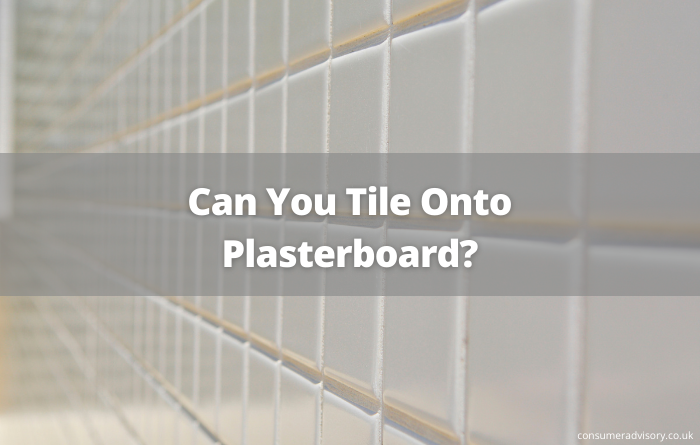
Can you tile onto plasterboard? Yes, you can tile onto plasterboard. However, you’ll need to consider the weight of the tiles that you plan to use, as well as the condition of the plasterboard before you begin your tiling project.
In this article, we’ll explore tiling onto plasterboard in more detail. We’ll discuss how to prepare your plasterboard for tiling, and how to check that your plasterboard is suitable for tiling.
It is perfectly possible to tile over plasterboard in some situations. However, it is essential that you check the condition of your plasterboard before making the decision to tile over it, to ensure that it is strong enough to hold the weight of the tiles.
Standard plasterboard with plaster skim is able to support a maximum weight of 20kg per square meter. Without a plaster skim, this weight is increased to 32kg per square meter. However, it isn’t just the tiles you need to take into consideration – you’ll also need to consider the weight of the tile grout and adhesive. These typically add an extra 2kg – 4kg per square meter.
You’ll also need to check the condition of your plasterboard. In order to be suitable for tiling, your plasterboard will need to be dry, as well as being securely attached to the wall. It should have a minimum thickness of 12.5mm and should not have any dents that may affect the adherence of tiles to the wall. If your plasterboard is damaged or weak, it could be at risk of crumbling. This could lead to tiles falling off your wall.
If upon inspection you find that your plasterboard will not support the weight of your tiles, or is not in good enough condition to be tiled over, you will need to consider installing cement board to your wall. This can support up to 200kg per square meter, giving you a sturdy surface on which to tile.
If you’re thinking about tiling over plasterboard, you might be wondering whether you’ll need to prime your plasterboard before you begin.
Plasterboard is an absorbant material, so it soaks up the tile adhesive. This can prevent it from adhering to the tiles properly. Priming your plasterboard will help the tile adhesive to securely hold the tiles on the wall, by preventing it from soaking into the plasterboard.
So, we recommend always priming your plasterboard before tiling onto it.
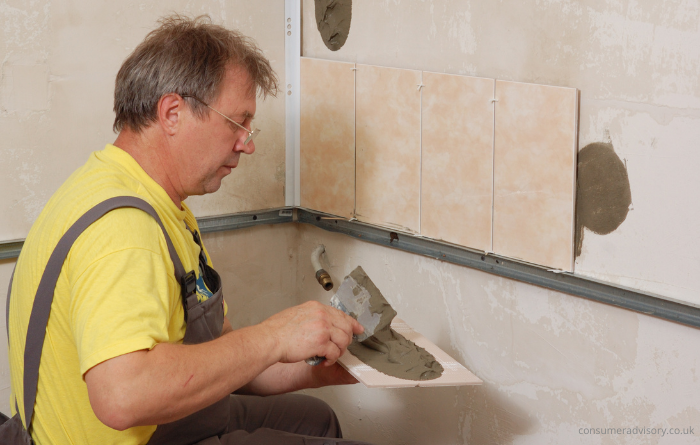
Before you can tile onto plasterboard, you will first need to prepare your plasterboard for tiling. This means priming the plasterboard to allow the tile adhesive to stick to the plasterboard securely.
Before priming your plasterboard, you’ll need to ensure that it is clean and dry. If it’s dirty, wipe over with a damp cloth and allow to dry fully before painting. You’ll then need to use a large roller or brush to apply an acrylic-based primer to your plasterboard. This will need to fully dry before tiling begins, so it’s best to prime your plasterboard the day before you want to begin tiling.
If your plasterboard has any joins, it’s best to use joining tape on these before you begin priming. This will help to reinforce the joins, ready for tiling.
You might have seen it recommended on some websites to apply PVA glue to your plasterboard as a primer. However, this is not recommended and could actually lead to your walls and your tiles becoming damaged.
Unlike primer, PVA glue is unable to soak into your plasterboard. Instead, it sits on top of your plasterboard in a layer, preventing the adhesive from soaking into the plasterboard. The adhesive therefore sits on top of the PVA layer, meaning that the tiles are only held onto the wall by this layer of PVA glue, instead of the plasterboard itself.
It’s best to use an acrylic-based primer to prepare your plasterboard for priming, rather than PVA glue. Although PVA may seem like a cheaper alternative, you may end up paying for it later down the line if your tiles begin falling off the wall.
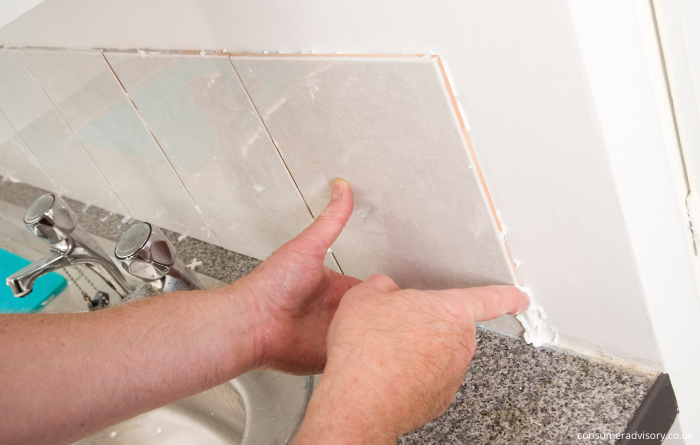
How much weight your plasterboard will be able to support will depend on whether it has a plaster skim. If it has a plaster skim, it will be able to hold up to 20kg per square meter. If is does not have a plaster skim, it will be able to hold up to 32kg per square meter.
You’ll need to ensure that you include the weight of the tile adhesive and grout in your calculations, as well as the tiles themselves. You can expect adhesive and grout to add between 2kg and 4kg to the weight per square meter.
It’s also essential that you ensure that your plasterboard is at least 12.5mm in thickness before making the decision to tile onto it. If your plasterboard is less than 12.5mm thick, it will not be strong enough to hold the weight of tiles.
If you’re considering tiling over a stud wall, you might be wondering whether you need to plaster the wall first.
You might be surprised to learn that plasterboard does not need to be skimmed before tiling. In fact, the plasterboard will hold more tile weight if it is left unskimmed. For this reason, many adhesive manufacturers will actually recommend that you tile directly onto plasterboard without plastering it first.
However, it’s important to note that when the tiles are replaced in future, you will need to replace the plasterboard. This is because removing tiles that have been attached directly to the plasterboard will damage the board, leaving it in need of replacement.
Before tiling, you will need to prime your plasterboard with an acrylic-based primer. Do not be tempted to use alternatives such as PVA glue, as these reduce the adhesion of the tiles to the plasterboard.
After the primer has fully dried (following the manufacturer’s instructions), you will be able to begin tiling your wall.
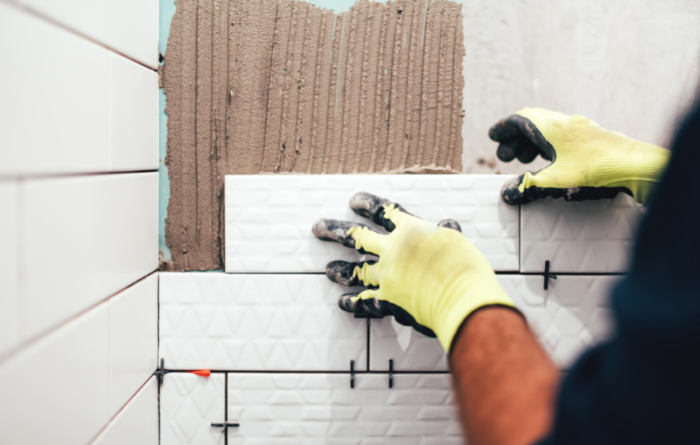
You can tile onto plaster walls, as long as the plaster is at least 4 weeks old. This will ensure that the plaster has had time to fully dry out, making it strong enough to support the weight of the tiles.
It’s important to note that plastered walls can support weights of up to 20kg per square meter. You’ll need to include the weight of the tiles, adhesive and grout in your calculations.
If you’re getting ready to begin your tiling project, you might be wondering whether it is better to tile on plasterboard or plaster. Either of these materials are suitable for tiling, but you need to be aware of the weight restrictions to avoid causing damage to your walls, or the tiles falling off the wall.
An unskimmed plasterboard wall can support up to 32kg per square meter in weight, whilst a plaster skimmed wall can support up to 20kg per square meter. You’ll need to factor in 2kg – 4kg per square meter for the adhesive and grout, along with the weight of your chosen tiles.
So, whether you can tile on plasterboard or plaster will depend on the weight of the tiles that you are using for your tiling project.
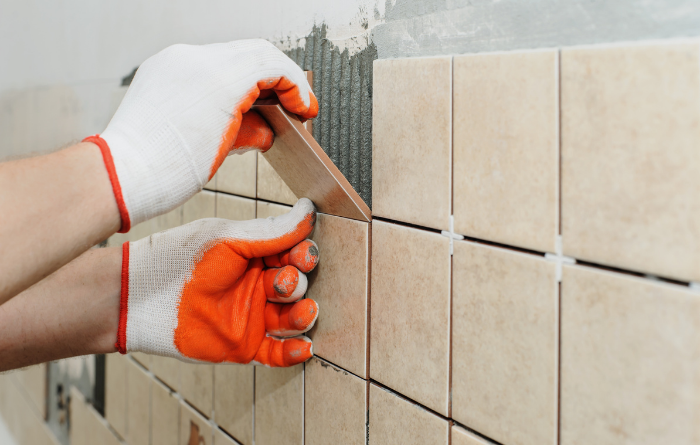
It’s possible for tiles to fall off walls sometimes, though it’s important to be aware that there are some factors that can greatly increase your chances of this happening.
The type of adhesive you choose plays a major role in how likely the tiles are to stay stuck on the wall. Cheap adhesives will often mean that your tiles will fall off the wall over time. This is because they do not provide a strong enough bond for tiles to be fixed on with. If you are dealing with an uneven surface, it’s especially important to use an adhesive that gives a strong hold.
Tiles that have been fitted incorrectly are also more likely to fall off the wall in time, especially if they are fitted in an uneven manner. Be sure to read the installation instructions for your tiles closely, and adhere to them carefully. If there are particular steps you’ve missed or failed to complete, it’s possible that your tiles will fall off the wall at some point in time.
If you apply PVA glue to your wall as a primer, you will significantly increase the risk of your tiles falling off the wall. This is because the tiles will be stuck to the layer of PVA glue rather than the wall itself.
Tiles that have become damaged over time might also end up falling off the wall. If grout has built up between the tiles, or if a tile becomes cracked, it might break away from the wall and end up falling to the floor.
Drywall, known as plasterboard in the UK, is a lightweight material that is often used for covering walls. It is perfectly possible to hang tiles on drywall, but it’s important that you are aware of the weight restrictions.
If you are using lighter tiles, with a total weight of less than 32kg per square meter, it’s possible to hang them on drywall without the need for any additional support. However, if you are using heavier tiles, you may need to reinforce the drywall with a sheet of concrete.
You can tile directly onto a painted wall without any problems, providing that the paint is in good condition. You’ll need to allow for drying time between the painting and your tiling project, so it might be worth leaving at least 2 weeks before you begin tiling on top of the newly painted surface.
Tile can be used both inside and outside, but it’s important to choose the right tiles for the situation. For tiling outdoors, you’ll need to choose tiles that specify they are suitable for outdoor use.
If you are using an adhesive that specifies it is for indoor use, this will not be suitable for outdoor conditions. It’s important to avoid using adhesives that have a tendency to yellow over time outdoors, as the colour of your tiles might become altered.
Tile can also be used outdoors on a rooftop terrace or garden patio. If you aren’t planning on using adhesive to fix your tiles, you’ll need to use a thin-set mortar instead. This is slightly different to the types of mortar that are suitable for internal tiling projects, so make sure that you follow the instructions carefully.
Tiles are attached to walls in a couple of different ways. The main options available for this are adhesive and thin-set mortar.
You can attach tiles using an “adhesive”. This refers to the process of applying a layer of adhesive to the wall, and then pressing the tiles in place. Once you’ve done this, you’ll need to leave the adhesive an hour or so to dry before proceeding with your project.
You can also attach tiles using “thin-set mortar”. This is a type of plaster that sets harder than wet plaster, and allows you to proceed with your tiling project immediately after applying it.
The best option is entirely dependent on the type of tiles you are using, and the surface you are attaching them to.
If decorative tiles are being attached to a wall covered with plasterboard, adhesive is the recommended option. This allows the adhesive to grip onto both the wall and decorative tile simultaneously. If thin-set mortar is used, the adhesive will only grip onto the wall.
‘Can you tile onto plasterboard?’ is a commonly asked question by DIY enthusiasts. Whilst it is perfectly possible to do this, you’ll need to carefully consider the condition of the plasterboard, as well as the weight of the tiles you intend to use.
Copyright © 2025 Consumer Advisory. All rights reserved.